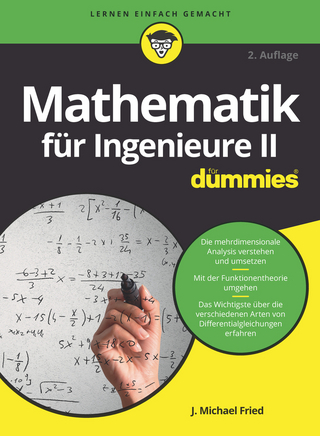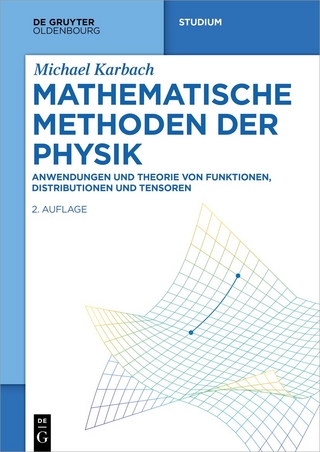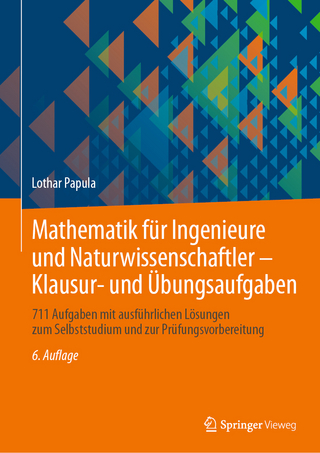
System Dynamics and Controls
CL Engineering (Verlag)
978-0-357-87920-7 (ISBN)
- Noch nicht erschienen (ca. Juli 2024)
- Versandkostenfrei innerhalb Deutschlands
- Auch auf Rechnung
- Verfügbarkeit in der Filiale vor Ort prüfen
- Artikel merken
Dr. Kelly received his Ph.D. in Engineering Mechanics from Virginia Tech. He was a faculty member in the Department of Aerospace and Mechanical Engineering at the University of Notre Dame and later in the Department of Mechanical Engineering at the University of Akron. His service at Akron included stints as Assistant/Associate Dean of Engineering, Assistant/Associate Provost and Interim Dean of Engineering. He is currently Emeritus Professor of Mechanical Engineering.
Part 1: Introduction.
1. Dynamic Systems.
2. Dimensions and Units.
3. Mathematical Modeling of Dynamic Systems.
4. System Components.
5. System Response.
6. Linearization of Differential Equations.
7. Unit Impulse Function and Unit Step Function.
8. Stability.
9. MATLAB.
10. Scope of Study.
11. Summary.
Part 2: Laplace Transforms.
1. Definition and Existence.
2. Determination of Transform Pairs.
3. Laplace Transform Properties.
4. Inversion of Transforms.
5. Laplace Transform Solution of Differential Equations.
6. Further Examples.
7. Summary.
Part 3: Transfer Function and State Space Modeling.
1. Introduction.
2. Transfer Functions for Systems with One Independent Variable (SISO Systems).
3. Transfer Function for Systems with Multiple Independent Variables (MIMO Systems).
4. State Variables and the State-space Method.
5. State Space Models for System with Derivatives of the Input in the Mathematical Model.
6. Transfer Functions from the State-Space Model for SISO Systems.
7. A State-Space Model from the Transfer Function.
8. Transfer Functions for A MIMO System from State-Space Model.
9. Further Problems.
10. Systems with a Time Delay.
11. Use of MATLAB.
12. Summary.
Part 4: Mechanical Systems.
1. Inertia Elements.
2. Springs.
3. Friction Elements.
4. Mechanical System Input.
5. Free-Body Diagrams.
6. Newton�s Laws.
7. Single-Degree-Of-Freedom Systems.
8. Multidegree-Of-Freedom Systems.
9. Energy Methods.
10. Transfer Functions for Mechanical Systems.
11. State Space Formulation for Mechanical Systems.
12. Further Examples.
13. Summary.
Part 5: Electrical Systems.
1. Charge, Current, Voltage, And Power.
2. Circuit Components.
3. Kirchoff�s Laws.
4. Circuit Reduction.
5. Mathematical Modeling of Electric Circuits.
6. Mechanical Systems Analogies.
7. Operational Amplifiers.
8. Electromechanical Systems.
9. Transfer Functions for Electrical Systems.
10. State-Space Modeling of Electrical Circuits.
11. Further Examples.
12. Summary.
Part 6: Fluid, Thermal, and Chemical Systems.
1. Introduction.
2. Control Volume Analysis.
3. Pipe Flow.
4. Modeling of Liquid-Level Systems.
5. Pneumatic and Hydraulic Systems.
6. Thermal Systems.
7. Chemical Systems.
8. Biological Systems.
9. Transfer Functions for Transport Systems.
10. State Space Modeling of Transport Systems.
11. Further Examples.
12. Summary.
Part 7: Transient Analysis and Time Domain Response.
1. System Response Using Transfer Functions.
2. Transient Response Specification.
3. Stability Analysis.
4. First-Order Systems.
5. Second-Order Systems.
6. Higher-Order Systems.
7. Systems with Time Delay.
8. Further Examples.
9. Summary.
Part 8: Frequency Response.
1. Undamped Second-Order Systems.
2. Sinusoidal Transfer Function.
3. Frequency Response.
4. Bode Diagrams.
5. Nyquist Diagrams.
6. Use of MATLAB to Develop Bode Plots and Nyquist Diagrams.
7. First-Order Systems.
8. Second-Order Systems.
9. Higher-Order Systems.
10. Response Due to Periodic Input.
11. Further Examples.
12. Summary.
Part 9: Feedback Control Systems.
1. Block Diagrams.
2. Diagram Modeling Using SIMULINK.
3. Feedback Control.
4. Types of Controllers.
5. Electronic, Hydraulic, Pneumatic, And Mechanical Controllers.
6. Properties of Control Systems.
7. Feedback Control of First-Order Plants.
8. Control of Second-Order Plants.
9. Parallel Feedback Loops.
10. Further Examples.
11. Summary.
Part 10: Root-Locus Analysis.
1. Introduction.
2. Definitions.
3. The Angle and Magnitude Criteria.
4. Breakaway and Break-in Points.
5. Asymptotes of Branches on the Root-locus Diagram.
6. Summary of Steps in Drawing a Root-Locus Diagram.
7. Use of MATLAB.
8. Control System Design Using Root-Locus Method.
9. Tuning of PID Controllers.
10. Lead Compensators.
11. Lag Compensators.
12. Lead-Lag Compensators.
13. Further Problems.
14. Summary.
Part 11: Steady-state Analysis of Control Systems.
1. Introduction.
2. The Nyquist Stability Criterion.
3. Phase Margin and Gain Margin.
4. Steady-state Properties.
5. Frequency Response Design of Control Systems.
6. PID Controller Design.
7. Design of Lead Compensators.
8. Design of Lag Compensators.
9. Design of Lead-lag Compensators.
10. Further Problems.
11. Summary.
Part 12: State-Space Methods.
1. An Example in The State Space.
2. State-Space Solutions for Free Response.
3. State-Space Analysis of Response Due to Inputs.
4. Numerical Solutions.
5. MATLAB and SIMULINK Modeling in The State-Space.
6. Nonlinear Systems and Systems with Variable Coefficients.
7. Root-Locus Analysis in The State-Space.
8. State Variable Feedback.
9. State Variable Feedback with Integral Control.
10. Determination of The Ackerman Matrix.
11. Further Examples.
12. Summary.
Appendix A Complex Algebra.
Appendix B Matrix Algebra.
Appendix C MATLAB.
| Erscheint lt. Verlag | 12.7.2024 |
|---|---|
| Sprache | englisch |
| Themenwelt | Sonstiges ► Geschenkbücher |
| Mathematik / Informatik ► Mathematik ► Angewandte Mathematik | |
| Technik | |
| ISBN-10 | 0-357-87920-1 / 0357879201 |
| ISBN-13 | 978-0-357-87920-7 / 9780357879207 |
| Zustand | Neuware |
| Haben Sie eine Frage zum Produkt? |
aus dem Bereich


